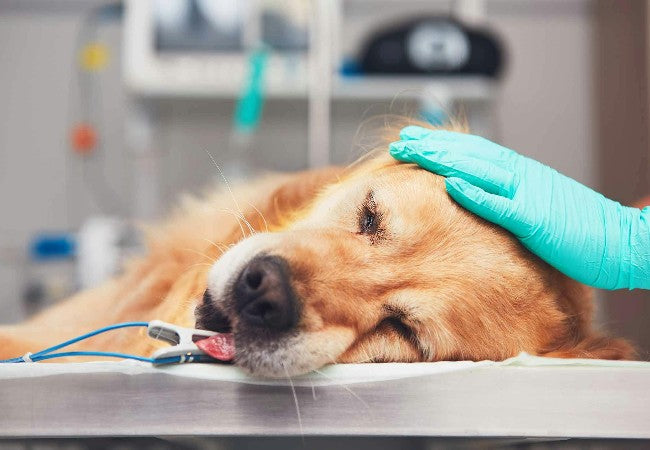Vet’s Guide to Lung Cancer in Dogs in 2025 🩺🐶

In this article
Vet’s Guide to Lung Cancer in Dogs in 2025 🩺🐶
By Dr. Duncan Houston BVSc
Introduction Lung cancer in dogs is uncommon—representing only about 1 % of canine cancers—but it remains serious when present. In this detailed 2025 guide, we’ll explore the types (primary vs metastatic), clinical signs, modern diagnostics, treatment options (including surgery, chemo, radiation), prognosis factors, and supportive care approaches. We’ll also highlight telehealth support via Ask A Vet, enriched recovery 🐾.
1️⃣ What Is Lung Cancer in Dogs?
Lung tumors in dogs can be primary (originating in lung tissue) or metastatic (spreading from another cancer elsewhere). Primary carcinomas—especially bronchoalveolar types—account for ~97 % of primary lung cancers, while the majority of lung tumors are metastatic. Primarily affecting older dogs (9–12 years), there is no strict breed or sex predisposition, though breeds like Boxers, Dobermans, Aussies, Irish Setters, and Bernese Mountain Dogs may show increased risk.
2️⃣ How Common Is It?
Only ~1 % of canine cancers originate in the lung, but metastatic lesions are more frequent. Detection rates have risen due to healthier, older pets, better imaging, and environmental exposures like secondhand smoke.
3️⃣ Symptoms & Clinical Signs 📋
- Coughing Often non-productive, sometimes bloody. Content Reference [oaicite6]{index=6}.
- Increased respiratory effort or rate at rest or during exercise.
- Lethargy, weight loss, decreased appetite.
- Exercise intolerance and labored breathing.
- Hypertrophic osteopathy Swollen, firm long bones causing lameness.
- Pleural effusion: Fluid accumulation causing acute breathing distress.
- Other signs Fever, lymph node swelling, coughing up blood, vomiting/regurgitation.
Note ~25 % of dogs show no obvious symptoms and are found during routine imaging.
4️⃣ Primary vs Metastatic Lung Tumors
Primary tumors originate in lung tissue, usually as solitary nodules. Prognosis is encouraging if caught early and is surgically removable. Metastatic tumors come from cancers elsewhere and often present multiple lung lesions, reducing treatment success.
5️⃣ Diagnosing Lung Cancer 🩺
🔹 Physical Exam & Baseline Screen
Includes listening for abnormal lung sounds, checking lymph nodes, and assessing overall health via blood tests and urinalysis.
🔹 Imaging
- Chest X‑rays: First diagnostic step; nodules >5 mm visible, though small metastases might be missed (~40 % of metastatic lesions).
- CT scan: Gold standard—detects smaller nodules, helps surgical planning, and checks lymph node involvement.
- Abdominal imaging & lymph node checks assess for spread.
🔹 Fine Needle Aspiration (FNA) & Biopsy
Samples lung tissue or fluid cells; can be done via ultrasound guidance, bronchoscopy, or CT. Biopsies (core/excisional) provide definitive diagnosis.
🔹 Staging
Staging in dogs is based on tumor size, lymph node spread, and metastasis; akin to human staging I–IV.
6️⃣ Treatment Options in 2025
🔹 Surgery (Lobectomy)
The mainstay for solitary non‑metastatic lung tumors. Removing the affected lobe, thoracoscopy (keyhole surgery) is less invasive, with a faster recovery.
🔹 Chemotherapy
Used when tumors are high-grade, metastatic, or unresectable. Vinorelbine is used in dogs, though evidence is limited. Carbo‑ or doxorubicin may be used in metastatic disease, reference.
🔹 Radiation & Targeted Therapies
Options like stereotactic radiation can help in non-surgical cases. Regional chemotherapy and targeted drugs are emerging but less studied.
🔹 Palliative Care
For advanced or inoperable cases cough suppressants, pain relief, anti-anxiety meds, appetite support, and easy-care options like rest areas, humidifiers.
7️⃣ Prognosis & Survival Time ⏳
| Scenario | Expected Survival |
|---|---|
| Surgically removed, no lymph node involvement | ~12 months |
| Lymph node spread or multiple tumors | ~2 months |
| Metastatic disease, palliative care | <3 months |
Survival depends on tumor grade, spread, clinical signs, and treatment aggressiveness.
8️⃣ Factors Influencing Prognosis
- Stage at diagnosis (early = better outcome)
- Clinical signs—lack thereof predicts longer survival.
- Tumor size and histologic grade
- Lymph node and metastasis involvement
9️⃣ Monitoring & Follow-up
- CT or chest X-rays every 3–6 months post-op for recurrence monitoring
- Routine blood tests during chemo to track organ function
- Telehealth check-ins via Ask A Vet for home-based symptom tracking and medication guidance
🔟 Support & Quality of Life
- Smoke-free, purified-air home environment
- Balanced diet; easy access to meals and water
- Gentle exercise, avoiding strenuous periods
- Frequent cozy rest periods and vet follow-up via Ask A Vet
🔁 When to Contact a Vet
- New or worsening cough, labored breathing, rapid breathing rate
- Appetite loss, weight loss, decreased activity
- New lameness or limb swelling
- Known lung mass—schedule staging and treatment planning
- Consider referral to specialists for CT scans, surgery, oncology, and radiation
🏁 Final Thoughts
Though rare, lung cancer in dogs is serious—and treatable in many cases. Early detection, advanced diagnostics, and modern treatments like lobectomy, chemo, and radiation can offer meaningful quality and duration of life, even up to a year or more. When combined with at-home support via and Ask A Vet telehealth, pet parents can deliver compassionate, effective care tailored for 2025.
For personalized treatment strategies, tele-vet follow-ups, or urgent advice, visit AskAVet.com and download the Ask A Vet app today 🐾📱.






